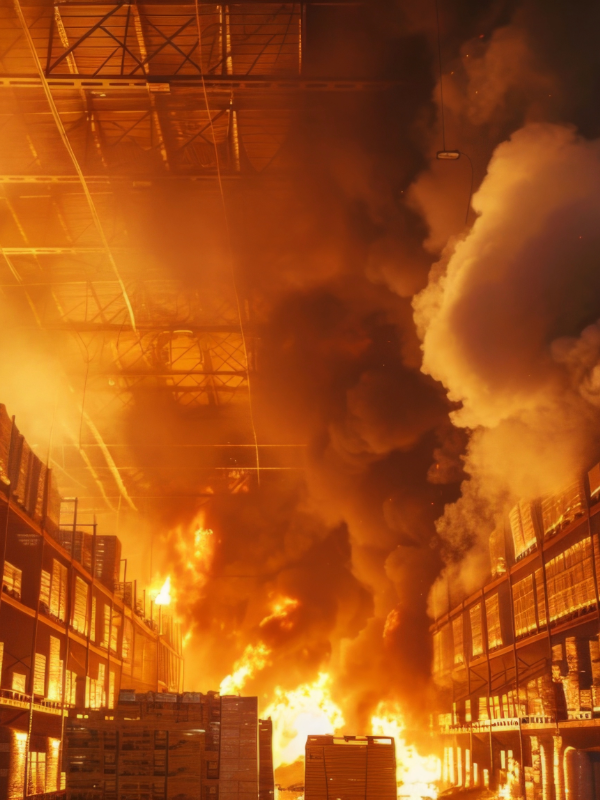We look at how the effects of fire can be devastating to businesses with 3 real-world examples.


Posted on
October 24, 2025
By
When it comes to fire protection, the question isn’t just “Can we afford a sprinkler system?” but rather “Can we afford not to have one?” Thousands of businesses across the UK have discovered that without robust fire safety protocols—including automatic sprinklers—the financial, operational and reputational consequences can be devastating.
Below we share real examples of what happens when fire safety is lacking, and how installation of a proper system could have made all the difference.
In March 2023, a newly-opened warehouse belonging to Gardman (a garden supplies distributor) was completely destroyed by fire. The building had no sprinkler system.
Key takeaway: A large company with a high value of stock and distribution commitments suffered catastrophic losses simply because a critical protection measure (sprinkler coverage) was omitted.
In May 2016, Total Polyfilm (a plastics manufacturer) experienced a fire at their unsprinklered factory.
Key takeaway: Even a profitable business can collapse if fire safety is inadequate and recovery is delayed and complicated.
In January 2024, a 20,000 m² warehouse housing multiple businesses was destroyed by fire. The site had no sprinkler system.
Key takeaway: For multi-occupant industrial estates, the ripple effect of fire without sprinklers impacts many businesses—not just one owner.
Poor fire safety doesn’t always result only in fire damage, but also regulatory enforcement and reputational damage. Two examples:
Key takeaway: Substandard fire safety protocols—even without a major fire—can lead to heavy financial penalties, regulatory action, and potential business collapse.

At A&F Sprinklers we see first-hand how effective fire-sprinkler systems help protect businesses like yours. Whether you operate a warehouse, factory, hotel, residential block or commercial office, the cost of not having adequate protection can far exceed the cost of doing things properly.
With many major companies and estates facing £10’s-100’s of millions in losses or remediation (for example the remediation bill for the former Olympic Village was estimated at £432 million), it becomes clear that fire-safety is both a risk management and asset-protection strategy.
When you compare the futures of the companies in the examples above with those that had effective sprinkler protection, the message is clear: investing in fire-sprinkler systems is not simply a cost—it is a safeguard for continuity, asset protection and long-term business viability.
If you’d like to explore how a tailored sprinkler solution could protect your premises, assets and people, we’d be happy to provide a consultation and walk you through the options.

When it comes to fire protection, the question isn’t just “Can we afford a sprinkler system?” but rather “Can we afford not to have one?” Thousands of businesses across the UK have discovered that without robust fire safety protocols—including automatic sprinklers—the financial, operational and reputational consequences can be devastating.
Below we share real examples of what happens when fire safety is lacking, and how installation of a proper system could have made all the difference.
In March 2023, a newly-opened warehouse belonging to Gardman (a garden supplies distributor) was completely destroyed by fire. The building had no sprinkler system.
Key takeaway: A large company with a high value of stock and distribution commitments suffered catastrophic losses simply because a critical protection measure (sprinkler coverage) was omitted.
In May 2016, Total Polyfilm (a plastics manufacturer) experienced a fire at their unsprinklered factory.
Key takeaway: Even a profitable business can collapse if fire safety is inadequate and recovery is delayed and complicated.
In January 2024, a 20,000 m² warehouse housing multiple businesses was destroyed by fire. The site had no sprinkler system.
Key takeaway: For multi-occupant industrial estates, the ripple effect of fire without sprinklers impacts many businesses—not just one owner.
Poor fire safety doesn’t always result only in fire damage, but also regulatory enforcement and reputational damage. Two examples:
Key takeaway: Substandard fire safety protocols—even without a major fire—can lead to heavy financial penalties, regulatory action, and potential business collapse.

At A&F Sprinklers we see first-hand how effective fire-sprinkler systems help protect businesses like yours. Whether you operate a warehouse, factory, hotel, residential block or commercial office, the cost of not having adequate protection can far exceed the cost of doing things properly.
With many major companies and estates facing £10’s-100’s of millions in losses or remediation (for example the remediation bill for the former Olympic Village was estimated at £432 million), it becomes clear that fire-safety is both a risk management and asset-protection strategy.
When you compare the futures of the companies in the examples above with those that had effective sprinkler protection, the message is clear: investing in fire-sprinkler systems is not simply a cost—it is a safeguard for continuity, asset protection and long-term business viability.
If you’d like to explore how a tailored sprinkler solution could protect your premises, assets and people, we’d be happy to provide a consultation and walk you through the options.